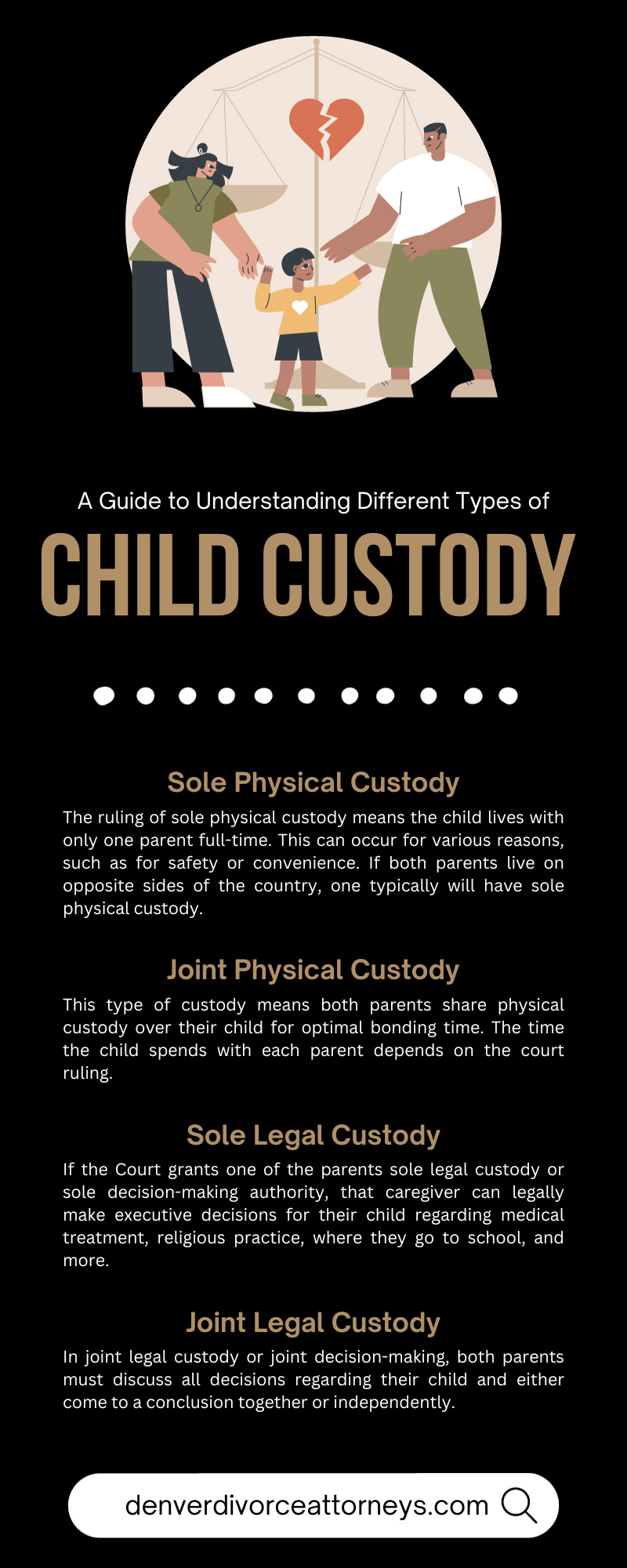Going through a child custody case during divorce is one of the hardest parts of the split. You love your child unconditionally and likely want to spend every waking minute with them. However, when you and your partner divorce or separate, you may have to share custody over your child(ren) based on the legal ruling. In this guide to understanding different types of child custody, we’ll explain the key details you need to know before moving forward.
Defining Child Custody
Child custody refers to the guardianship arrangement for a child after their parents split up. In Colorado, custody is referred to as “parenting time.” When parents get divorced, the split impacts the entire family unit. If you have children, you have to decide with your co-parent how you’ll carry out parental duties after the split. If you and your co-parent cannot agree, the judge will decide for you.
Custody often depends on what would be best for the child, whether that be one parent having sole custody or both sharing the responsibility. Generally, the Court prefers the latter option whenever possible since it allows the child to maintain a healthy bond with both parents.
Pro Tip
Both parents have equal rights to advocate for custody, and having a lawyer represent you in court can help protect your rights. Jones Law Firm, PC has Denver fathers’ rights lawyers who can help you reach your ideal outcome.
Types of Child Custody
Child custody depends on various factors, but it always comes down to what would be best for the child. The types of child custody include the following:
- Sole physical custody
- Joint physical custody
- Sole legal custody
- Joint legal custody
Each type of custody impacts the child and parents differently. If both parents are caring and can provide their child with a safe, stable place to live, shared physical and legal custody is the most likely.
Sole Physical Custody
The ruling of sole physical custody means the child lives with only one parent full-time. This can occur for various reasons, such as for safety or convenience. If both parents live on opposite sides of the country, one typically will have sole physical custody. In this instance, the child may visit or spend vacation time with the noncustodial parent, especially if it’s a safe environment. If the noncustodial parent could endanger the child, they do not need to communicate with one another.
Joint Physical Custody
Joint physical custody is the next type in our guide to understanding different types of child custody. This type of custody means both parents share physical custody over their child for optimal bonding time. The time the child spends with each parent depends on the court ruling. Sometimes, parents alternate each week, but other times, one parent has full custody on weekdays while the other has weekends.
Sole Legal Custody
If the Court grants one of the parents sole legal custody or sole decision-making authority, that caregiver can legally make executive decisions for their child regarding medical treatment, religious practice, where they go to school, and more. Usually, the Court awards this type of custody if one parent’s decision-making could endanger the child or if sole legal custody would benefit the child.
Joint Legal Custody
In joint legal custody or joint decision-making, both parents must discuss all decisions regarding their child and either come to a conclusion together or independently. For instance, the child may go to separate daycare facilities depending on which parent they’re with.
This type of custody also allows parents to make independent decisions in an emergency. For example, if the child needs to go to the emergency room, there may not be time to contact the other parent. However, they must contact them as soon as possible to explain the situation and decision.
What Impacts Custody?
Many factors can alter the outcomes of a child custody case. If one parent is absent or displays abusive behavior, they’re less likely to get custody. These are other factors impacting child custody:
- Distance between parents
- Parent-child relationship
- Mental and physical health of parents
- Environment of each home
These are just some of the many factors the Court considers. At the core, the child’s well-being is always the priority.
Keep in mind that the judge evaluates all criteria surrounding the case to decide whether one or both parents are fit. Additionally, courts always strive to keep siblings together and consider the child’s verbalized preferences.
Tips for Moving Forward
During the process of deciding custody, set your feelings aside and consider what’s best for your child. Divorce is hard on kids, and some children have a healthy bond with both parents—they shouldn’t feel forced to give that up. Below, we’ve detailed several tips to consider as you move forward.
Communicate With Your Ex
Calmly communicating with the other party is ideal if it’s safe. Consider working with a mediator to keep the split simple if the divorce is amicable. You could also use a service such as Talking Parents or Our Family Wizard to have your communications with the other party monitored. Maintain cordial communication with your ex after the divorce if you two share physical, legal, or physical and legal custody. Remember that your child is always the priority; shutting out your ex will make the process harder.
Encourage Healthy Bonding
Avoid talking badly about your ex to or around your child. Relationships with both parents are important to children, and talking badly about your ex could hinder this. Additionally, most judges don’t like seeing this behavior; it could work against you during the custody case.
Instead, you should encourage your child to bond with their other parent. Meet up with your ex on time to drop off your kid or have your child ready for pickup. The goal is to work with your ex so your child always enjoys the time spent with each of you.
Know Your Rights
Understanding your legal rights is vital, as it allows you to advocate for yourself and know what to expect. Unless determined unfit, parents usually have the right to see their children. The more you learn about family law, the easier it is to navigate your custody case.
Since legal terms can be complex and laws have various nuances, hiring a family law attorney is best. With a reputable lawyer, you can rest assured they’ll help you achieve your legal goals in the courtroom. Additionally, a lawyer will tell you which documents you need and explain each step of the child custody process.
Contact Jones Law Firm, PC
Jones Law Firm, PC has over two decades of experience working in family law in Colorado. When you hire one of our lawyers, our team stands behind you throughout the case. We always strive for the best results based on our client’s goals. Contact our team today to learn more about our services or to schedule a free consultation.


